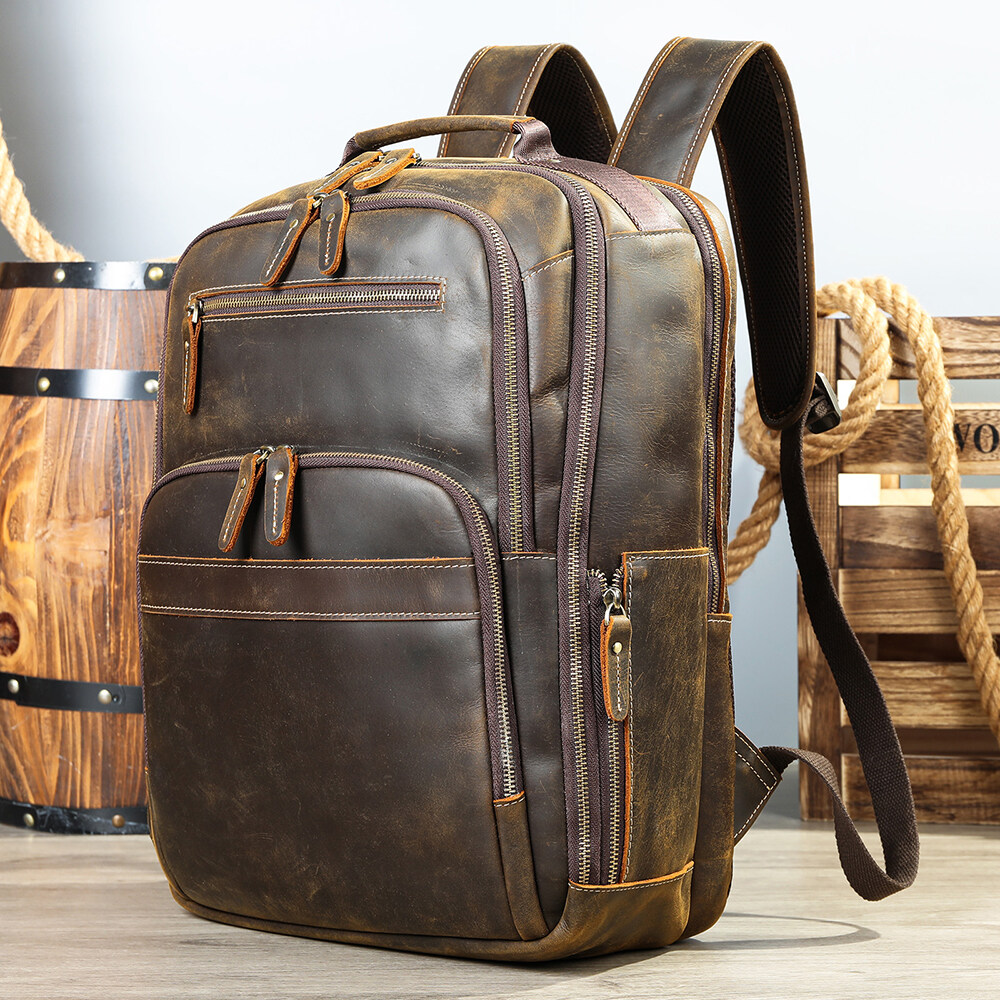Email cannot be empty
Password cannot be empty
Email format error
Email cannot be empty
Email already exists
6-20 characters(letters plus numbers only)
The password is inconsistent
Email format error
Email cannot be empty
Email does not exist
6-20 characters(letters plus numbers only)
The password is inconsistent


The Evolution and Craftsmanship of the China Leather Briefcase
Leather briefcases have long been a symbol of sophistication and professionalism. They are more than just a practical accessory; they embody a rich tradition of craftsmanship and artistry. Among the various sources of high-quality leather briefcases, China stands out for its unique blend of historical depth and modern innovation. This article explores the historical background of leather craftsmanship in China and delves into the meticulous process of crafting a China leather briefcase.
1. Historical Background of Leather Craftsmanship in China
1.1 Historical Overview
Leatherworking in China has a storied past that dates back thousands of years. The origins of leathercraft can be traced to ancient China, where leather was used for a variety of purposes including clothing, armor, and ceremonial items. During the Shang Dynasty (1600-1046 BCE), leather was a prized material, and early Chinese artisans developed rudimentary techniques for tanning and working with animal hides.
As centuries passed, these techniques evolved significantly. During the Han Dynasty (206 BCE-220 CE), leatherworking became more sophisticated. Artisans refined their methods for tanning and began to develop more complex leather products. The use of leather in China continued to evolve through the Tang (618-907 CE) and Song (960-1279 CE) Dynasties, periods known for their cultural and technological advancements. It was during these times that leatherworking techniques were further refined and diversified.
The Ming Dynasty (1368-1644 CE) marked a significant period in the evolution of leathercraft. This era saw the introduction of new tools and methods that allowed for greater precision and creativity. The Ming Dynasty's influence is still evident in many traditional Chinese leatherworking techniques used today.
1.2 Traditional Techniques
Traditional Chinese leatherworking techniques are deeply rooted in the country’s history. One of the oldest methods still in use today is vegetable tanning. This process involves using natural tannins found in plant materials such as oak and chestnut to tan the leather. Vegetable-tanned leather is known for its durability and ability to develop a beautiful patina over time.
Hand-stitching is another traditional technique that remains prevalent in the production of high-quality leather goods, including China leather briefcases. This method involves stitching leather pieces together by hand, often using waxed thread. Hand-stitching not only ensures the strength and durability of the briefcase but also adds a touch of artisanal charm.
These traditional techniques are often combined with modern innovations to create products that are both timeless and contemporary. For example, while the principles of vegetable tanning remain the same, modern tanners use advanced equipment to enhance the efficiency and consistency of the process. Similarly, while hand-stitching is still done by skilled artisans, contemporary tools and techniques have been developed to support this traditional practice.
1.3 Cultural Significance
Leather goods have held significant cultural value in China for centuries. Historically, leather was associated with status and prestige. During ancient times, leather armor and clothing were worn by emperors and high-ranking officials, symbolizing their power and authority. The craftsmanship involved in creating these items was highly regarded, and skilled leatherworkers were considered to be artisans of the highest order.
In traditional Chinese culture, leather items were also used in various festivals and ceremonies. For example, during the Chinese New Year, leather goods were often featured in ceremonial displays and rituals, reflecting their importance in cultural practices. The meticulous craftsmanship of leather items was seen as a reflection of the maker's skill and dedication.
Even today, the cultural significance of leather goods remains strong in China. Modern Chinese artisans continue to honor traditional methods while incorporating contemporary design elements. This fusion of old and new reflects the ongoing appreciation for leather craftsmanship in Chinese culture.
2. The Process of Crafting a China Leather Briefcase
2.1 Material Selection
The process of crafting a China leather briefcase begins with the selection of leather. The choice of material is crucial, as it affects both the appearance and durability of the final product. Various types of leather are used in the production of briefcases, including full-grain, top-grain, and corrected-grain leather.
Full-Grain Leather: This is the highest quality of leather, made from the top layer of the hide. It retains the natural grain and imperfections, which contribute to its unique character and durability. Full-grain leather develops a rich patina over time, making each briefcase distinctive.
Top-Grain Leather: This leather is slightly less durable than full-grain but is more resistant to staining and scratching. It is made from the second layer of the hide and is often sanded to remove imperfections. Top-grain leather is commonly used in high-quality briefcases that require a smoother finish.
Corrected-Grain Leather: This type of leather is treated to correct imperfections and achieve a uniform appearance. It is generally more affordable but lacks the natural beauty and character of full-grain and top-grain leather.
Choosing the right type of leather depends on the desired qualities of the briefcase. For a luxurious and durable product, full-grain leather is often preferred. However, top-grain and corrected-grain leathers are also used depending on the design and price point.
2.2 Manufacturing Steps
Once the leather has been selected, the process of crafting a China leather briefcase involves several meticulous steps.
Tanning Process: The first step in manufacturing is tanning, which preserves the leather and enhances its durability. Traditional vegetable tanning uses natural tannins to create a rich, long-lasting material. Modern methods also include chrome tanning, which is faster and results in a more flexible leather. Both methods are used depending on the desired characteristics of the briefcase.
Dyeing Techniques: After tanning, the leather is dyed to achieve the desired color. Traditional dyes are often used to maintain the natural look and feel of the leather, while modern dyes can provide a wider range of colors and finishes. The dyeing process is carefully controlled to ensure an even application and prevent color bleeding.
Stitching and Assembly: The cut pieces of leather are stitched together to form the briefcase. This step often involves hand-stitching, where skilled artisans use waxed thread to create strong, durable seams. The stitching not only adds to the briefcase’s durability but also contributes to its aesthetic appeal.
Finishing Touches: Once assembled, the briefcase undergoes finishing processes. This includes polishing the leather to enhance its shine and applying protective coatings to guard against moisture and stains. The final inspection ensures that each briefcase meets high standards of quality.
2.3 Artisanal Skills
Creating a high-quality China leather briefcase requires exceptional artisanal skills. The craftsmanship involved is both intricate and labor-intensive, reflecting the dedication and expertise of the artisans.
Craftsmanship Techniques: Artisans use a range of techniques to ensure the briefcase is both functional and aesthetically pleasing. This includes precise cutting of leather pieces, careful hand-stitching, and expert dyeing and finishing. Each step requires a high level of skill and attention to detail.
Role of the Artisan: The artisan plays a crucial role in the production process. From selecting the leather to the final inspection, their expertise ensures that each briefcase meets rigorous standards. The artisan’s touch is evident in the smooth seams, precise stitching, and overall quality of the briefcase.
Challenges in Craftsmanship: Artisans face several challenges, including working with natural variations in leather and maintaining consistency in quality. Despite these challenges, skilled artisans are able to produce leather briefcases that are both beautiful and durable.
Conclusion
The China leather briefcase is a testament to the rich history and exceptional craftsmanship of Chinese leatherworking. From its ancient origins to the modern-day, the art of leathercraft in China has evolved while maintaining a deep connection to its cultural roots. The meticulous process of selecting materials, crafting, and finishing ensures that each briefcase is not only functional but also a piece of art.
The blend of traditional techniques with contemporary innovations results in a product that embodies both elegance and practicality. As you carry a China leather briefcase, you are not just holding a stylish accessory; you are carrying a piece of history and craftsmanship that reflects the dedication and skill of generations of artisans.
In an ever-changing world, the enduring appeal of the China leather briefcase serves as a reminder of the value of quality and tradition. It is a symbol of sophistication and craftsmanship that continues to resonate with professionals and collectors around the globe.

